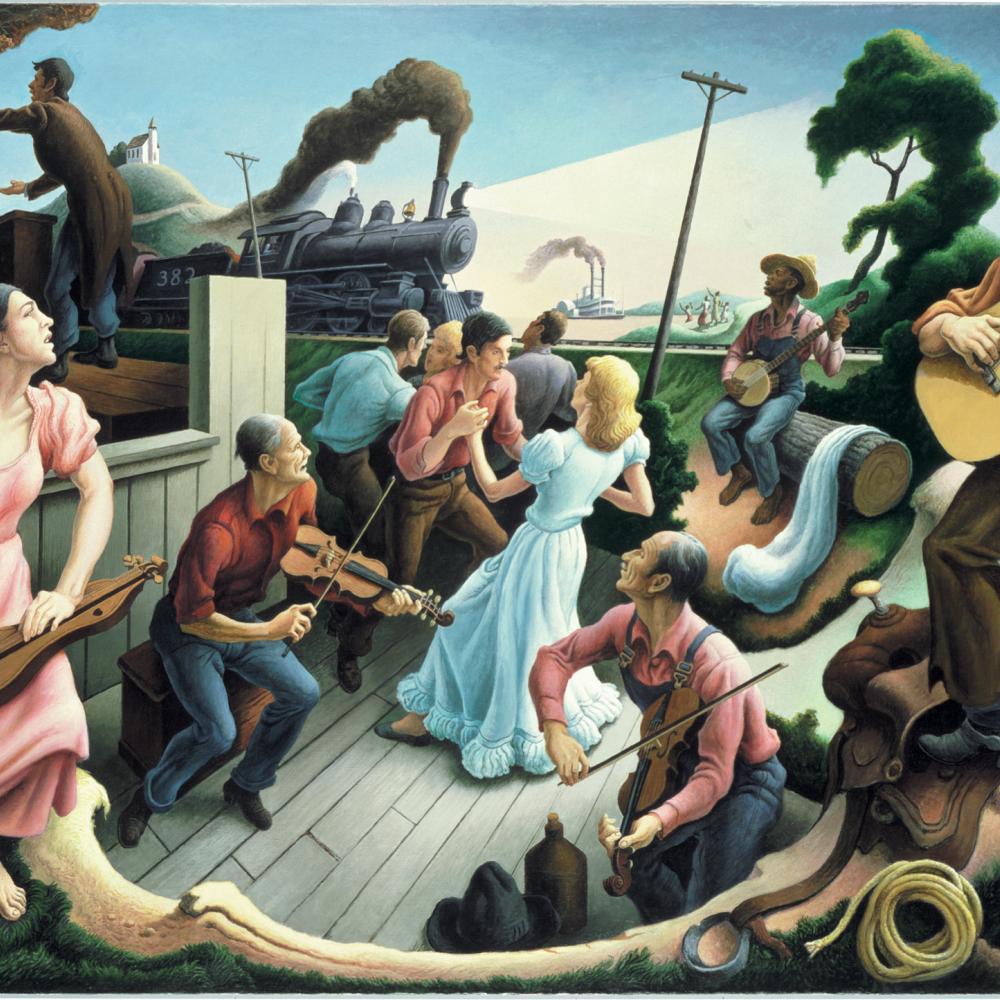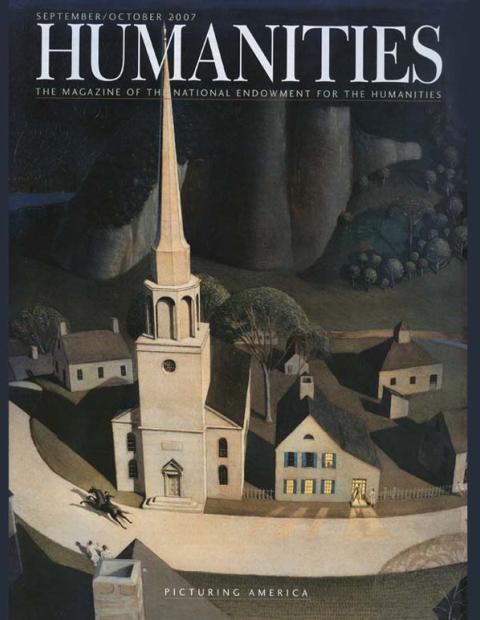Like the mountain music he loved, the rowdy life of American artist Thomas Hart Benton has the larger-than-life quality of folklore. His reckless behavior, heavy drinking, profanity, and belligerence toward any artist who took a different stylistic or ideological path scandalized people from New York to New England to Missouri. Over the years he opposed abstract painters, curators, homosexuals, intellectuals, Harvard, New York City, Kansas City, women, and old friends such as Alfred Stieglitz, Jackson Pollock, and Lewis Mumford. An atavistic and occasionally demonic drive compelled him to measure each person he met and each idea he encountered against a dogged ethos distilled from egomania, pragmatism, and a good dose of populism.
At the same time, his purposeful figures—he often painted muscular men and women hard at work—and his industriousness—he worked fast, drove all over the country, built his own houses, raised kids, fished and swam—assuaged a Depression-era anxiety among average folk and critics alike. He was a modernist, and he believed in progress, but his paintings tapped into a Jeffersonian image of determined yeomanry; Benton reminded Americans of their original, if also mythical, sense of themselves.
An often-told story about Benton is that he died in his studio just moments before he was to sign his name on his final painting, The Sources of Country Music, which he was making for the Country Music Hall of Fame and Museum in Nashville. The painting had been commissioned two years earlier, in 1973, by the Country Music Foundation, whose board members traveled to Benton's home in Kansas City, Missouri, and, over a bottle of Jack Daniels, persuaded him to accept the commission.
Though old and frail, Benton was enthusiastic about the project. Decades earlier, his art had been cast aside by critics, who viewed the ascension of Abstract Expressionism and Jackson Pollock, Benton's student in the early 1930s, as a confirmation that Benton's popular realism had become quaint and irrelevant. Benton was happy for the opportunity to execute another public work that would address the folk culture he believed superior to the "intellectual curiosities" and “infinitely shaded egotism” of modernist aesthetics.
William Ivey, then executive director of the Country Music Foundation, recalled that Benton decided that the painting “should show the roots of the music—the sources—before there were records and stars.” Benton received $60,000 for the project, with a third of the money coming from the National Endowment for the Arts.
As was his custom, Benton developed the painting from drawings—in this case, some old sketches that he'd made on walkabouts through the Ozark Mountains in the 1920s and some new ones made on a trip to Branson, Missouri, where he observed professional country musicians. The painting depicts more than a dozen figures divided into different vignettes: In the center, a group dances to the sounds of two fiddlers; in the foreground, a man plays guitar and a woman plays a dulcimer; and, alone in the background, an African-American man picks at a banjo. On an elevated stage to the left, we see a choir, and behind it the Wabash Cannonball, the train celebrated in songs by the Carter Family and Roy Acuff, barreling down the tracks.
The painting is distinguished by the rhythmic postures of the figures; the complementary diagonals of fiddle bows, guitar necks, and tilting telephone poles; and the visceral music itself, which seems to swirl through the canvas.
As a child, Benton was exposed to the expert fiddle playing of Pappy Wise, his maternal grandfather, and the piano playing of his mother Lizzie. During the Twenties, when Benton traveled through Virginia and Arkansas on sketching trips, music spilled out of the hills—hymns, bluegrass, and folk. Benton admired the “old boys, with their rheumatic arms,” who improvised and played in keys unlike those heard in the mainstream music of the day. “I like their plaintive, slightly nasal voices,” he wrote in his autobiography, An Artist in America, “and their way of short-bowing the violin.”
In the late Twenties, Benton picked up the harmonica, led an old-time band, and hung around New York's Greenwich Village with musicians and musicologists such as Carl Ruggles and Charles Seeger. Benton developed a unique tablature system for the harmonica and worked out arrangements for songs such as “House Carpenter,” “Casey Jones,” and “Fair Ellen.” Benton lamented that the “old music cannot last much longer,” continuing, “I count it a great privilege to have heard it in the sad twang of mountain voices before it died.”
Benton was conditioned to admire such rural customs. He was born in the small town of Neosho, Missouri, in 1889, and started to draw at a young age. Besides Custer's Last Stand, his favorite subject was trains. “Engines,” he wrote, “were the impressive things that came into my childhood. . . . To . . . see them come in, belching black smoke, with their big headlights shining and their bells ringing and feeling of stupendous drama. . . . I scrawled crude representations of them over everything.”
Drama, it seems, was one of his birthrights. He claimed that his “family [was] fated . . . for turmoil,” adding, “I was raised in a family environment which conditioned me very early in my life to accept strife and argument as basic factors of existence.” He was named after his great-uncle, Senator Thomas Hart Benton, a Democrat from Missouri who nearly killed Andrew Jackson in a duel in 1813. Later, in 1817, Senator Benton did kill a man, a St. Louis lawyer named Charles Lucas, in a duel on so-called Bloody Island, a sandbar in the Mississippi River.
Benton's father, Maecenas Eason Benton, known as the Colonel, was also a Democratic politician, who represented Missouri in the U.S. Congress from 1897 to 1905. Benton and his father bickered constantly. The Colonel wanted his son to be a lawyer, and maybe even to go into politics. When Benton announced that he wanted to be an artist, his father reacted cruelly, mocking his ambition. As Benton remembered it, his father hated artists. “The only ones he had ever come across were the mincing, bootlicking portrait painters of Washington,” he explained, “who hung around the skirts of women at receptions and lisped a silly jargon about grace and beauty. Dad was utterly contemptuous of them and labeled them promptly as pimps.”
Nevertheless, father and son traveled together on political campaigns throughout rural Missouri, where the Colonel brought his populist message to the stump and communed with his constituents at boisterous rallies. The panel Politics, Farming, and Law in Missouri, from Benton's 1936 mural A Social History of the State of Missouri, represents one such campaign stop. It shows the Colonel at a podium working a crowd of Missouri producers—farmers, loggers, and mothers busy with their babies—while young boys scamper around, oblivious to the goings-on.
One of the most stubborn myths surrounding Benton's career is that he was a Midwestern artist. Though he moved to Kansas City in 1935, and remained there until his death forty years later, each summer he and his wife Rita lived on Martha's Vineyard, the quintessential New England island, which they'd started visiting regularly in 1920. For almost thirty years, from 1907 until 1935, Benton enjoyed the life of a cosmopolitan artist, residing first in Chicago, where he studied at the Art Institute, and then in Paris, where he attended various academies and tried his hand at an irresolute bohemianism. He then settled in New York, where he socialized with the leading artists and writers of the day and experimented with modern styles, including Cubism and Synchromism, a peculiar kind of color abstraction developed by his close friend Stanton Macdonald-Wright. Benton was at the center of the New York art world for almost fifteen years, exhibiting at leading galleries, teaching at the Art Students League, professing Marxism, and socializing with the coterie of artists associated with Alfred Stieglitz and his famed 291 Gallery, a modernist sanctuary.
Yet his contrarian streak kept him out of step with artistic fashion. Stieglitz, a photographer, gallery owner, and the husband of Georgia O'Keeffe, was the guiding light of New York modernism, loaning money and exhibition space to dozens of the era's most important painters. But Benton told anyone who would listen that Stieglitz was really an elitist, egomaniacal formalist who cared more about art's attitudes than about whether or not it was “useful.”
In 1935, Benton remarked in the journal Common Sense that Stieglitz's "illusory promise of achievement through 'mood cultivation' is now dead.” Of the 291 Gallery he said, “I am certain that no place in the world ever produced more idiotic gable [sic]. . . . The contagion of intellectual idiocy there rose to unbelievable heights.”
The congressman's son naturally took sides in the politics of his day, and ostracized former New York allies by turning against Marxism. Until the late 1920s, his politics were decidedly leftist. “I had agreed,” he wrote, “that what was needed for 'peace and progress' was a 'people's society,' one where the people, that is, would have control over the instruments of production. . . . I was pro-labor, anti-big capitalist, and psychologically ready for large-scale social change." After his travels through rural America, however, Benton started to express doubts about Communist politics, explaining that the "horse sense that remained in this Missouri lawyer's son” compelled him to identify Marxism as nothing more than dogma, just another kind of “Bossism.” By the 1930s, when Benton produced most of his murals, he was a liberal Democrat who supported Roosevelt's New Deal and abhorred centralized power and wealth. But to most of his old New York friends, he was simply a defector—an opportunist playing off the nation's desire during the Depression for a glimpse of its old productive self.
In early 1935, Benton announced he was leaving New York and moving to Kansas City. He told an interviewer it was because New York had become “feeble and querulous and touchy” and had “lost its masculinity.” His punishment for such crassness was to observe from afar as Pollock's star rose while his own brand of realist painting became passé. Yet Benton remained remarkably productive. Over the course of the next thirty years, he taught, rafted some of America's greatest rivers, and worked at a breakneck pace, producing such well-known paintings as his satirical Persephone and the idyllic Cave Spring.
The power of Benton's best murals—America Today, The Arts of Life in America, and A Social History of the State of Missouri—comes from his ability to transform seemingly mundane subjects into something grand: dancing, harvesting, theatergoing, and even drinking are invested with monumental significance because he treats them as constituents of a larger epic. Benton integrates varied people and activities, and shows the connections between individual practices and communal health. The Sources of Country Music is Benton's last attempt at illustrating this romantic view. The anonymity of the players and the dancers is meant to tell us that our regional customs and spontaneous rituals, not our theories, account for the nation's energetic force. That this ideology comes from a man who was so curious and so crude—and that it fits all kinds of political rhetoric, from Reaganesque conservatism to liberal populism—is what makes Benton such a magnetic subject. We want to pin him down precisely because we cannot.


